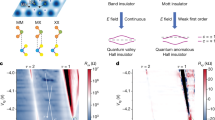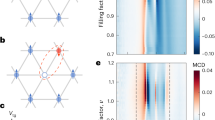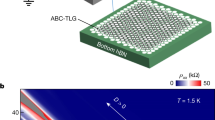Abstract
The Kondo lattice—a matrix of local magnetic moments coupled through spin-exchange interactions to itinerant conduction electrons—is a prototype of strongly correlated quantum matter1,2,3,4. Usually, Kondo lattices are realized in intermetallic compounds containing lanthanide or actinide1,2. The complex electronic structure and limited tunability of both the electron density and exchange interactions in these bulk materials pose considerable challenges to studying Kondo lattice physics. Here we report the realization of a synthetic Kondo lattice in AB-stacked MoTe2/WSe2 moiré bilayers, in which the MoTe2 layer is tuned to a Mott insulating state, supporting a triangular moiré lattice of local moments, and the WSe2 layer is doped with itinerant conduction carriers. We observe heavy fermions with a large Fermi surface below the Kondo temperature. We also observe the destruction of the heavy fermions by an external magnetic field with an abrupt decrease in the Fermi surface size and quasi-particle mass. We further demonstrate widely and continuously gate-tunable Kondo temperatures through either the itinerant carrier density or the Kondo interaction. Our study opens the possibility of in situ access to the phase diagram of the Kondo lattice with exotic quantum criticalities in a single device based on semiconductor moiré materials2,3,4,5,6,7,8,9.
This is a preview of subscription content, access via your institution
Access options
Access Nature and 54 other Nature Portfolio journals
Get Nature+, our best-value online-access subscription
$29.99 / 30 days
cancel any time
Subscribe to this journal
Receive 51 print issues and online access
$199.00 per year
only $3.90 per issue
Buy this article
- Purchase on Springer Link
- Instant access to full article PDF
Prices may be subject to local taxes which are calculated during checkout




Similar content being viewed by others
Data availability
Source data are provided with this paper. All other data are available from the corresponding authors upon reasonable request.
References
Stewart, G. R. Heavy-fermion systems. Rev. Mod. Phys. 56, 755–787 (1984).
Kirchner, S. et al. Colloquium: heavy-electron quantum criticality and single-particle spectroscopy. Rev. Mod. Phys. 92, 011002 (2020).
Paschen, S. & Si, Q. Quantum phases driven by strong correlations. Nat. Rev. Phys. 3, 9–26 (2021).
Coleman, P. Heavy fermions and the Kondo lattice: a 21st century perspective. Preprint at https://arxiv.org/abs/1509.05769 (2015).
Kennes, D. M. et al. Moiré heterostructures as a condensed-matter quantum simulator. Nat. Phys. 17, 155–163 (2021).
Mak, K. F. & Shan, J. Semiconductor moiré materials. Nat. Nanotechnol. 17, 686–695 (2022).
Maksimovic, N. et al. Evidence for a delocalization quantum phase transition without symmetry breaking in CeCoIn5. Science 375, 76–81 (2022).
Senthil, T., Vojta, M. & Sachdev, S. Weak magnetism and non-Fermi liquids near heavy-fermion critical points. Phys. Rev. B 69, 035111 (2004).
Vojta, M. Orbital-selective Mott transitions: heavy fermions and beyond. J. Low Temp. Phys. 161, 203–232 (2010).
Andrei, E. Y. et al. The marvels of moiré materials. Nat. Rev. Mater. 6, 201–206 (2021).
Andrei, E. Y. & MacDonald, A. H. Graphene bilayers with a twist. Nat. Mater. 19, 1265–1275 (2020).
Cao, Y. et al. Unconventional superconductivity in magic-angle graphene superlattices. Nature 556, 43–50 (2018).
Tang, Y. et al. Simulation of Hubbard model physics in WSe2/WS2 moiré superlattices. Nature 579, 353–358 (2020).
Regan, E. C. et al. Mott and generalized Wigner crystal states in WSe2/WS2 moiré superlattices. Nature 579, 359–363 (2020).
Wu, F., Lovorn, T., Tutuc, E. & Macdonald, A. H. Hubbard model physics in transition metal dichalcogenide moiré bands. Phys. Rev. Lett. 121, 026402 (2018).
Kumar, A., Hu, N. C., Macdonald, A. H. & Potter, A. C. Gate-tunable heavy fermion quantum criticality in a moiré Kondo lattice. Phys. Rev. B 106, L041116 (2022).
Guerci, D. et al. Chiral Kondo lattice in doped MoTe2/WSe2 bilayers. Preprint at https://arxiv.org/abs/2207.06476 (2022).
Ramires, A. & Lado, J. L. Emulating heavy fermions in twisted trilayer graphene. Phys. Rev. Lett. 127, 026401 (2021).
Dalal, A. & Ruhman, J. Orbitally selective Mott phase in electron-doped twisted transition metal-dichalcogenides: a possible realization of the Kondo lattice model. Phys. Rev. Res. 3, 043173 (2021).
Song, Z.-D. & Bernevig, B. A. Magic-angle twisted bilayer graphene as a topological heavy fermion problem. Phys. Rev. Lett. 129, 047601 (2022).
Vaňo, V. et al. Artificial heavy fermions in a van der Waals heterostructure. Nature 599, 582–586 (2021).
Li, T. et al. Quantum anomalous Hall effect from intertwined moiré bands. Nature 600, 641–646 (2021).
Li, T. et al. Continuous Mott transition in semiconductor moiré superlattices. Nature 597, 350–354 (2021).
Zhao, W. et al. Realization of the Haldane Chern insulator in a moiré lattice. Preprint at https://arxiv.org/abs/2207.02312 (2022).
Zhang, Y., Devakul, T. & Fu, L. Spin-textured Chern bands in AB-stacked transition metal dichalcogenide bilayers. Proc. Natl Acad. Sci. USA 118, e2112673118 (2021).
Rademaker, L. Spin-orbit coupling in transition metal dichalcogenide heterobilayer flat bands. Phys. Rev. B 105, 195428 (2022).
Pan, H., Xie, M., Wu, F. & Sarma, S. D. Topological phases in AB-stacked MoTe2/WSe2: Z2 topological insulators, Chern insulators, and topological charge density waves. Phys. Rev. Lett. 129, 056804 (2022).
Devakul, T. & Fu, L. Quantum anomalous Hall effect from inverted charge transfer gap. Phys. Rev. X 12, 021031 (2022).
Varma, C. M. Mixed-valence compounds. Rev. Mod. Phys. 48, 219–238 (1976).
Gu, J. et al. Dipolar excitonic insulator in a moiré lattice. Nat. Phys. 18, 395–400 (2022).
Zhang, Z. et al. Correlated interlayer exciton insulator in heterostructures of monolayer WSe2 and moiré WS2/WSe2. Nat. Phys. 18, 1214–1220 (2022).
Fallahazad, B. et al. Shubnikov–de Haas oscillations of high-mobility holes in monolayer and bilayer WSe2: Landau level degeneracy, effective mass, and negative compressibility. Phys. Rev. Lett. 116, 086601 (2016).
Kadowaki, K. & Woods, S. B. Universal relationship of the resistivity and specific heat in heavy-fermion compounds. Solid State Comm. 58, 507–509 (1986).
Kitagawa, S. et al. Metamagnetic behavior and Kondo breakdown in heavy-fermion CeFePO. Phys. Rev. Lett. 107, 277002 (2011).
Gegenwart, P., Si, Q. & Steglich, F. Quantum criticality in heavy-fermion metals. Nat. Phys. 4, 186–197 (2008).
Mak, K. F., Xiao, D. & Shan, J. Light–valley interactions in 2D semiconductors. Nat. Photon. 12, 451–460 (2018).
Löhneysen, H. V., Rosch, A., Vojta, M. & Wölfle, P. Fermi-liquid instabilities at magnetic quantum phase transitions. Rev. Mod. Phys. 79, 1015–1075 (2007).
Paschen, S. et al. Hall-effect evolution across a heavy-fermion quantum critical point. Nature 432, 881–885 (2004).
Burdin, S., Georges, A. & Grempel, D. R. Coherence scale of the Kondo lattice. Phys. Rev. Lett. 85, 1048–1051 (2000).
Sarma, S. D. & Liao, Y. Know the enemy: 2D Fermi liquids. Ann. Phys. 435, 168495 (2021).
Wang, L. et al. One-dimensional electrical contact to a two-dimensional material. Science 342, 614–617 (2013).
Zhang, R., Koutsos, V. & Cheung, R. Elastic properties of suspended multilayer WSe2. Appl. Phys. Lett. 108, 042104 (2016).
Sun, Y. et al. Elastic properties and fracture behaviors of biaxially deformed, polymorphic MoTe2. Nano Lett. 19, 761–769 (2019).
Acknowledgements
We thank L. Fu, D. Guerci, A. Millis, A. Georges, A. Rubio, S. Todadri, A. Kumar, A. Potter, D. Chowdhury and Y. Zhang for discussions. This work was supported by the Air Force Office of Scientific Research under award number FA9550-19-1-0390 (transport measurements), the National Science Foundation (Platform for the Accelerated Realization, Analysis, and Discovery of Interface Materials) under cooperative agreement nos. DMR-2039380 (sample and device fabrication) and DMR-2004451 (optical measurements) and the US Department of Energy, Office of Science, Basic Energy Sciences, under award number DE-SC0019481 (analysis). This work is also funded in part by the Gordon and Betty Moore Foundation. The growth of the hBN crystals was supported by the Elemental Strategy Initiative of MEXT, Japan, and CREST (JPMJCR15F3), JST. We used the Cornell Center for Materials Research Shared Facilities supported through the NSF MRSEC programme (DMR-1719875) and of the Cornell NanoScale Facility, an NNCI member supported by NSF grant NNCI-2025233. We also acknowledge support from the David and Lucille Packard Fellowship (K.F.M.) and the Kavli Postdoctoral Fellowship (W.Z.).
Author information
Authors and Affiliations
Contributions
W.Z. and B.S. fabricated the devices. W.Z. and B.S. performed the electrical transport measurements and analysed the data with the help of Z.H.; K.K., Z.T. and W.Z. carried out the optical measurements; K.W. and T.T. grew the bulk hBN crystals; W.Z., K.F.M. and J.S. designed the scientific objectives and oversaw the project. All authors discussed the results and commented on the manuscript.
Corresponding authors
Ethics declarations
Competing interests
The authors declare no competing interests.
Peer review
Peer review information
Nature thanks Lihong Bao and the other, anonymous, reviewer(s) for their contribution to the peer review of this work. Peer reviewer reports are available.
Additional information
Publisher’s note Springer Nature remains neutral with regard to jurisdictional claims in published maps and institutional affiliations.
Extended data figures and tables
Extended Data Fig. 1 Schematic electrostatics phase diagram.
The (ν, E) phase diagram with regions defined by different fillings in MoTe2 and WSe2. Kondo lattice physics is realized in region II (νMo = 1 and νW = x); region III (νMo = 2 and νW = x) provides a control experiment. In addition to regions I, II and III discussed in the main text, we can also identify regions with νW = 0 and 0 < νMo < 2, where WSe2 is charge-neutral and only MoTe2 is hole-doped, as well as regions where holes are shared between the two TMD layers (νW > 0 and 0 < νMo < 1 and νW > 0 and 1 < νMo < 2).
Extended Data Fig. 2 Filling factor and electric field dependent Rxx at different magnetic fields.
a, b, c, Dependence of Rxx on the total filling factor ν and the out-of-plane electric field E at T = 1.6 K and B = 6 T (a), 9 T (b) and 11 T (c). The dashed lines mark the phase boundaries for region II and III. Region II cannot be identified at B = 6 T without Landau levels. The electric field span expands (shrinks) for region II (III) with increasing B.
Extended Data Fig. 3 Filling factor and electric field dependence of exciton reflection contrast.
a, b, The reflection contrast (RC) for the intralayer exciton resonance of WSe2 (a) and MoTe2 (b) as a function of filling factor and electric field at B = 0 T and T = 1.6 K. The peak RC and the spectrally integrated RC (over the exciton resonance) are shown in a and b, respectively. c, Filling factor dependence of the RC spectrum near the WSe2 exciton resonance at E = 0.6 V/nm. The much weakened neutral exciton resonance accompanied by the appearance of the Fermi polaron resonances for ν > 1 shows that the WSe2 layer is hole-doped above ν = 1. Repeated measurements at varying electric fields construct the full map in a. The sharp drop in the exciton RC with doping helps construct the black dashed line in a, above which WSe2 is hole-doped. d, e, Bottom gate voltage (Vbg) dependence of the RC spectrum near the MoTe2 exciton resonance at top gate voltages Vtg = −3 V (d) and Vtg = −4.6 V (e). While holes are only doped into the MoTe2 layer in d, holes are shared between the two TMD layers in e. Similar to WSe2, the neutral exciton resonance (near 1.14 eV) is weakened substantially when MoTe2 is hole-doped (e.g., near Vbg = 3 V in d). The charged exciton resonance is enhanced at the insulating states at ν = 1 and 2 (e.g., green dashed lines in d). Multiple moiré exciton resonances are also observed near ν = 1. Similar results are also observed in e except now the WSe2 layer also becomes hole-doped. As a result, there is an extended span in Vbg (bound by the green dashed lines and indicated by the arrows) that the MoTe2 layer is kept in an insulating state (Mott insulator for ν = 1 + x and moiré band insulator for ν = 2 + x). Repeating the measurements in d and e at varying Vtg constructs the full map in b. The extended regions bound by the green dashed lines in e together with the black dashed line in a help identify region II and III in b.
Extended Data Fig. 4 Determination of the WSe2 hole mass from quantum oscillations.
a, b, c, Temperature dependence of the quantum oscillation amplitude ΔRxx as a function of νW at B = 13.6 T for region I (a), II (b), III (c). The filling factor dependence of Rxx at T = 10 K, where there is no quantum oscillation, is used as a background to obtain ΔRxx. The insets show the fits of |ΔRxx| versus T to \({\Delta R}_{{\rm{xx}}}={R}_{{\rm{a}}}\frac{\lambda (T)}{{\rm{\sinh }}\lambda (T)}\) in order to obtain the mass mW. Here Ra is the amplitude and the thermal factor is \(\lambda \left(T\right)=2{\pi }^{2}{k}_{{\rm{B}}}T{m}_{{\rm{W}}}/\hbar {eB}\) (kB denotes the Boltzmann constant).
Extended Data Fig. 5 Additional data on magnetic destruction of Kondo singlets.
a, Magnetic field dependence of Rxx at T = 1.6 K in region II (solid curves) and III (dotted curves). Whereas a small magnetoresistance is observed in region III (except the quantum oscillations at high fields), a large, quadratic magnetoresistance is observed in region II before the magnetic destruction near 6 T. Rxx for the two regions become comparable after the magnetic destruction. b, Magnetic field dependence of Rxx at different temperatures in region II. The temperature dependence corresponds to that in Fig. 3f for RH.
Extended Data Fig. 6 Kohler’s scaling in region II.
Magnetoresistance (MR) as a function of the scaled magnetic field (by the zero-field Rxx ≡ RB=0) at ν = 1 + 0.3 and varying temperatures. All curves collapse to the trend \({MR}\propto {\left(\frac{B}{{R}_{B=0}}\right)}^{2}\) as shown by the black dashed line. The data further confirms the Fermi liquid behavior in region II.
Extended Data Fig. 7 Temperature dependence of Rxx at varying electric field in region II.
The solid lines are the best fits to the quadratic temperature dependence at low temperatures. The resistance peak/bump determines the Kondo temperature T*.
Extended Data Fig. 8 Reproducible results in device 2.
a, Dependence of Rxx on ν and E at B = 13.5 T and T = 1.6 K. The red dashed lines mark the boundaries of region II and III. b, c, Temperature dependence of Rxx at varying doping densities for ν = 1 + x (b) and ν = 2 + x (c). The solid lines are the best fits to the quadratic temperature dependence at low temperatures. d, e, Magnetic field dependence of RH (d) and Rxx (e) at T = 1.6 K for both ν = 1 + x (solid curves) and ν = 2 + x (dashed curves). A sharp change in RH at the critical magnetic field is observed only for ν = 1 + x; that at ν = 2 + x is nearly field independent.
Extended Data Fig. 9 Determination of the charge transfer gap.
Dependence of Rxx on the total filling factor ν and out-of-plane electric field E at B = 0 and T = 1.6 K. The green dashed circle marks the region for the quantum anomalous Hall (QAH) insulator. The critical electric field for band inversion at ν = 1 is marked by the red dashed line at E = 0.653 V/nm. The black dashed line shows the electric field (E = 0.645 V/nm) at which the data in Fig. 3 were taken. The charge transfer gap is given by the product of the interlayer dipole moment and the electric field difference ∆E.
Extended Data Fig. 10 Temperature dependence of |dRxx/dT| at varying WSe2 filling factor x.
The data were extracted by first smoothing the experimental temperature dependence of Rxx before taking numerical derivatives. The temperature T* is determined by the first minimum of |dRxx/dT| (marked by arrows).
Supplementary information
Rights and permissions
Springer Nature or its licensor (e.g. a society or other partner) holds exclusive rights to this article under a publishing agreement with the author(s) or other rightsholder(s); author self-archiving of the accepted manuscript version of this article is solely governed by the terms of such publishing agreement and applicable law.
About this article
Cite this article
Zhao, W., Shen, B., Tao, Z. et al. Gate-tunable heavy fermions in a moiré Kondo lattice. Nature 616, 61–65 (2023). https://doi.org/10.1038/s41586-023-05800-7
Received:
Accepted:
Published:
Issue Date:
DOI: https://doi.org/10.1038/s41586-023-05800-7
This article is cited by
-
Heavy fermions vs doped Mott physics in heterogeneous Ta-dichalcogenide bilayers
Nature Communications (2024)
-
Hopping frustration-induced flat band and strange metallicity in a kagome metal
Nature Physics (2024)
-
Optical readout of the chemical potential of two-dimensional electrons
Nature Photonics (2024)
-
Observation of spin polarons in a frustrated moiré Hubbard system
Nature Physics (2024)
-
Realization of the Haldane Chern insulator in a moiré lattice
Nature Physics (2024)
Comments
By submitting a comment you agree to abide by our Terms and Community Guidelines. If you find something abusive or that does not comply with our terms or guidelines please flag it as inappropriate.



